
computer music and interactive media arts
midi, audio and video with object oriented programming in
Max/msp/Nato/GEM/Jitter

computer music and interactive media arts
midi, audio and video with object oriented programming in
Max/msp/Nato/GEM/Jitter
II) algorithmic composition, computer music and interactivity
a) synchronizing of traditional score writing and computer timingIII) interactive communication in media arts
b) generating structures in Max
c) midi controlling
IV) audio visual Interactivity
possibilities of interaction of sound and vision:
a) sound -> sound
b) sound -> image
c) image -> sound
d) image -> image
e) mixed media
Bergische Universität Wuppertal, workshop audiovisual interactivity and Max/Msp/Jitter
Lehrstuhl für Visuelle Kommunikation (institut for visual communication), Prof. Hans Günter Schmitz, organized by Wolfram Zwanziger, 12th-14th July 2004
Dongeui University, Pusan, South-Corea, From Minimal to Audiovisual, lecture by Andreas Weixler and Se-Lien Chuang for Pusan Electronic Music Association, November the 13th of 2003
TNCA Applied Music Department, Tainan National College of the Arts, Taiwan, 21. + 22. April 2003
Institut für Neue Musik, Staatliche Hochschule für Musik Freiburg, Germany, 7.-9. Februar 2003
Weinberg Castle, education centre of Upper Austria, lecture on 7th of May 2002, Event of the Bruckner-Conservatory
Institute of Electronic Music, University of Arts in Graz, Austria, lecture and workshop on 5th and 10th of December 2001, with Winfried Ritsch and Johannes Zmölnig, in German
National Taiwan University of Arts, Taipeh 13th. of November 2001, with Se-Lien Chuang, in Chinese and English.
Hochschule für Grafik und Buchkunst Leipzig, Germany, 16th - 17th of July 2001, in German
Nagoya City University - School of Design and Architecture, Japan, 19th January 2001, with Se-Lien Chuang and Mikako Mizuno in Japanese and English.
set upThe schedule of the workshop is very flexible from a lecture of 2-4 hours up to a practical workshop over several days
It is considered to be useful for beginners aswell as for advanced students of composition and media arts.
I will bring a Macintosh Powerbook and Software like Max/msp and Nato/GEM and some other equipment.

as a composer I am not only using software in a way they obviously
offer.
I am always intrested in new combinations and maybe alternative use of
software, which means using software differently from their first
intention
(like using a vacuum cleaner as a sound source).
I am using many different software for creating computer music and
media art. Also in teaching I like to encourage my students to go their
own way in using software.
The desire of creating my own technical tools was fullfilled by
using
object oriented languages like Max for ISPW on NeXT computer and
nowadays
Max/msp on Macintosh.
Of course in my artwork I also use standard software for hard disk
recording (SoundDesigner, ProTools a.o.), writing CDs, creating
Midi-Sequences
and score printouts (like Cubase) and so on and last but not least I
use
pencil and paper...
In computer music I was creating pieces in different fields.
All my compositions somehow belong together as a work in progress,
so you can see a comparison in using the available technology as well
as
in the structure of the composition itself. Some pieces quote each
other,
and sometimes I use the recordings of an instumental piece of mine to
create
electronic sound in the studio for the next one.
Now I would like to show you some examples of these catagories:
1) midi controlled devices- sampler & synthesizer2) algorithmic composition- score3) sound processing
- structure of composition- studio production4) interactivity
- multi channeling
- realtime-interactive communication5) audio visual
-audio reacts to audio- music video/audio-visual composition
- interactivity
-sound processes image
- image processes sound
also:
-image processes image
although these categories seem to be clear, very often a piece of
computer music is based in more than one catagory.
for example
Der letzte Wassermann (by Andreas Weixler)
includes many of these categories: first it is a live instrument with
tape, second it is multi channeling (4 channels), third it is granular
synthesis as sound processing of the recording of bowed piano, marimba
and a string trio.
or Trinity (computer animation by Se-Lien Chuang, computer
music
by Andreas Weixler)
first it is an audio visual and a music video. The visual is a computer
animation, the music is sound processing of comtemporary instrumental
sounds.
MIDI is a digital language for electronic musical instruments like synthesizer, sampler, computer and some special devices.Max/msp offers all kind of interaction of midi, audio and video objects. For example the audio can be controlled and affected by MIDI data as well as by video or audio itself.
MSP is a collection of Max objects for audio processing.
NATO/GEM are very new objects for quciktime video and OpenGL graphics
JITTER is a set of video, matrix, and 3D graphics objects for the Max graphical programming environment
more information on www.cycling74.com/
II) algorithmic composition, computer music and interactivity
a) synchronizing of traditional score writing and computer timingIII) interactive communication in media arts
b) generating structures in Max
c) midi controlling
IV) audio visual Interactivity
possibilities of interaction of sound and vision:
a) sound -> sound
b) sound -> image
c) image -> sound
d) image -> image
e) mixed media
The Max object orientated programming language as I want to introduce to you consist of
a) Max, the basic programm.functions of Max/msp/Nato/GEM
It has mathematical funktions and was designed for midi applications.
b) msp, the object library for audio processing.
c) Nato, the object library for video processing based on Quicktime.
d) GEM, Graphics Environment for Multimedia. It `s objects can create graphics based on OpenGL.
e) Jitter, quicktime video and OpenGL animation
1) algorithmic
as in all programming languages you can do complex mathematical calculations2) MIDI
the midi standard (MIDI = musical instruments digital inteface) enables the system to communicate with electronic musical instruments and can be also used for controlling several external devices.3) DSP
the objects of msp is opening the world of DSP (Digital Sound Processing) to Max, e.g. sampling, FFT, analysis, resynthesis and others4) GRAPHICS
the LCD object in Max allows simple graphic skills made out of circles, rectangles and lines and use those interactively for input and output.5) NATO
A portation of GEM by Shigeyuki Hirai (Kyoto) from PD for Linux/IBM computer to the Macintosh-platform opens the possibilities of OpenGL.
There are also several third party externals for displaying graphics and 3D, for example max3d by Shuichi Chino.
the Nato modules give full access to all Quicktime video functions. Again it can provide input by cameras and output on a screen and/or projector.6) JITTER
Also for visuals some other third party objects exist, which have the advantage to be free of charge like o- object by Ichi, mov by Shuichi Chino, videoin by Erik Singer
very well documentated object about quicktime video and OpenGL animation,
organisation and manipulation of matrices, and much more..
the SCRIPT
all these modules can be combined and mapped to each
other and depend on each other algorithmically.
I call this the script, which is considered to be part
of the artistic work. To make libraries and re-use them makes
programming
more comfortable by the time and creates your own personal way. For
this
it is necessary to think about a good architecture and naming.
example WAON








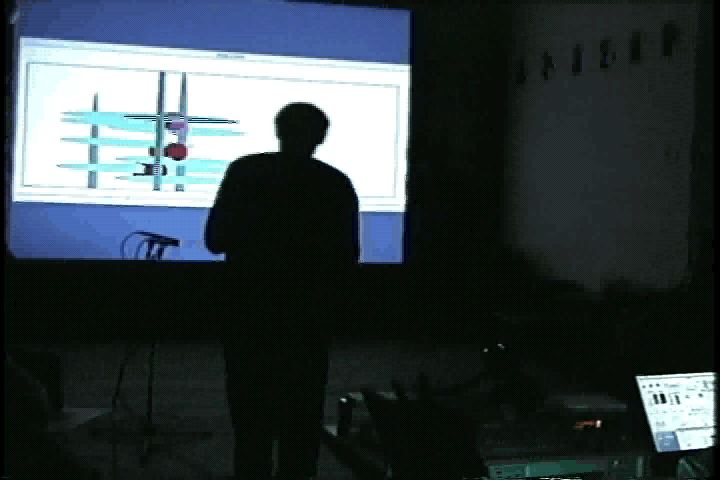 Waon
live
at Experimental Intermedia, New York, USA
Waon
live
at Experimental Intermedia, New York, USA
Waon
interactive audio visual performance for two instruments by Andreas
Weixler.
description: based on the Japanese spirit of harmony the computer senses harmony between the players and acts accordingly in generating audio and visual.
Studio: Sound Design Lab/Nagoya City University, School of Design
and
Architecture, Japan
premiere: 15.12.2000 Experimental Intermedia, New York, USA
selected for ISEA 02, Symposium of Electronic Art, in Nagoya, Japan
technique: Max/msp (fiddle~ objekt for analysis of
pitch
and dynamic, generating algortihmic structures, LCD object for
displaying
graphics)
a) synchronizing of traditional score writing and computer timing
b) generating structures in Max
c) midi controlling
a) synchronizing of traditional score writing and
computer timing
displaying timing as rhythm
computers "think" in time of milli seconds, but
musicians
like to play with traditional score printing, which means they divide a
pulse of time into proportions, like quavers, triplets etc.
If you like to write down a computer generated
composition
into tradtional score printing, you need a comparable timing.
It is very easy if you take tempo of 60 (means 60
beats
per minute). In other words this means one stroke per second.
To divide it is now easy for computer timing as well
as for the score:
a crotchet will be divded as follows:
the logical division into semiquavers:


If you overlay them all you get a resolution of one second as follows:

At the beginning and at the end it is less dense as in the middle part, and also you can see it is symmetrical.
! So what is this for ? This means an absolute
timing
of a computer calculation is transformed into a proportion of time.
The musiscian, who play this algorithmically generated part, does not
have
to play absolute time for example of 2 seconds and 34 milli
seconds
(which appears to be impossible for a human), but the musical correct
proportion
of 2 crotchets and the third of a triplet of semiquavers, which is the
next closest proportion.
Of courses this means there is some approximation in
the relations shown above. By the choice of crotchets, semiquavers,
quintlets
and triplets of semiquavers as the possible divisions of a time base of
60 beats per minute, I choose relations which make sense to both, the
computer
calculated accurate time and the musical rhythm a musicians can play
accordingly.
In other cases one has to be forced into the timing of the other, either the musician into absolute timing of the computer by playing with a click track or the computer has to be forced into the system of a proportion of time, i.e. rhythm, via score following for adjusting the time basis of his list of notes accordingly to the human interpretation of the score.
in der Zeit des Blühens (A.Weixler 2000)
algorithmic composition for traditional Chinese ensemble
instruments: dongxiao, sheng, pipa, guhzeng, daruan,
yanzin,
erhu and percussion
duration: 7 minutes
ensemble: China Found Music Workshop - Taipeh/Taiwan
premiere: 05.04.2000 Konzerthaus Wien,
Hörgänge

this score shows the variaton of the density of the
rhythms
very clearly .
The structures of timing are generated by a Max patch,
the data is exported as a midi file and transformed into a score by
importing
it into Cubase. The score then has been re-interpretated by hand
writting
to make sure a musical appearance of the data conversion.

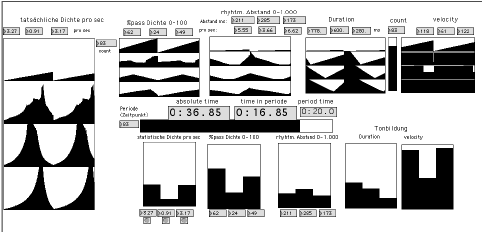
the Max patch "appear" for generating the structures of the rhythms and for instrumentation
Soundbarrier, live instruments will be
acoustically
displayed over multichannel loudspeaker system.
Max-patch: LAP

HyperControl
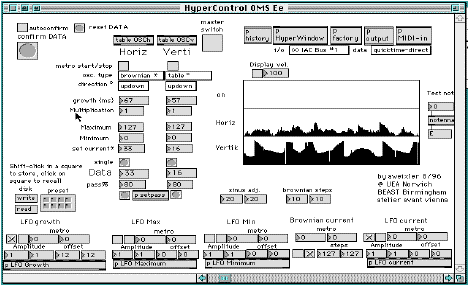

HyperControl is a Max patch for
controlling
the software HyperPrism for sound processing.
In that way the sound processing can be controlled
algorithmically.
Jade for orchestra on tape ( A.Weixler 1996)
description: computer music, algorithmic controlled
sound
processing of a contemporary orchestra
Dauer: 5:54
Hardware: PowerMac 7200/90, Macintosh Quadra 650 div
Peripheriegeräte
Software: ProTools 16Track, TDM Plugins: HTD, BRN, GRM,
Hyperprism 1.5.2, GRM Tools 1.55, SoundDesigner 2.8, Alchemy 3.0,
HyperControl,
Max 3.0, Soundhack 0.8
Studios: University of East Anglia , Norwich, BEAST
Birmingham
Electro Acoustic Sound Theatre, England
UA: Kunsthalle Stockerau 31.8.96
weitere Aufführungen:
WUK Wien 3-13.10.96 ProjektTheater Wien-New-York,
15.10.96 Theatro Austrian Sound Check/Steirischer
Herbst
,
14.u.15.11.97 Projekttheater Eva Brenner-Minoriten Graz
,
26.6.1997 European Electroacoustic Music Festival in
Brüssel ,
11.2.98 Electroacoustic Music Concert Montreal/Canada
,
15. 01.98 Konzert "Musik des 20. Jahrhunderts" Tiroler
Landeskonservatoriums,
10.11.98 Sumida Triphony Hall-Tokio/Japan
13.03.1999 Lange Nacht der Neuen Klänge,
Konzerthaus
Wien
11.05.99 Lüneburg 21. internatinale Studienwoche
zeitgenössischer Musik
15.12.2000 Experimental Intermedia, New York
 the
cat and
the mouse live in Lueneburg, Germany
the
cat and
the mouse live in Lueneburg, Germany
the cat and the mouse (1998)
ca.12´00
interactive realtime computer music for electric guitar, piano,
interactive
communication and ISPW audio processing
concept and prepared piano: Se-Lien CHUANG
ISPW- Max: Wolfgang MUSIL (Lüneburg), Thomas MUSIL (Graz)
electric guitar & Opcode- Max: Andreas WEIXLER
premiere: at the 21st international week of contemporary Music,
Lüneburg,
Germany 12.05.99
other premieres: ESC Labor/Graz at the V: NM Festivals 18. 05.1999
duration: circa 12´00
- - - - - - - in C (1998)
realtime processing for electric guitar, piano, interactive
communication
and ISPW audio processing
Se-Lien Chuang, composition and piano
Andreas Weixler, Opcode Max programming and electric guitar
Wolfgang Musil, ISPW-Max programming
Studios: Opcode-Max programming at Atelier Avant,
ISPW-Max programming Institute for Elektroacoustic Vienna
premiere: at the Alte Schmiede/Kunstverein Wien, Festivals Elektronischer Frühling ´98 Westöstlicher Divan: Taiwan in Wien - Wien in Taiwan 29/04/1998
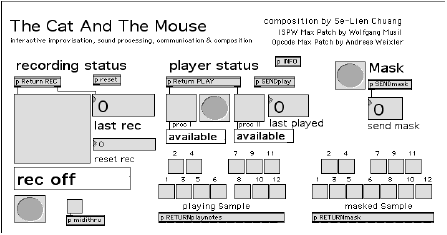
The improvised melody in this piece is basically
displayed
with 7 church-modes.
The cat and the mouse is computer aided composition in
which freezing, modulation, filtering and granular synthesis are used
to
complete the sound processing.
The reason for the cat and the mouse to be challenging
and gripping is because it's a interactive real time game between
guitar,
piano and the computer.
When the musicians are playing, the computer records
the sounds in real time, processes the recording sounds, and stores it
up. Then the musicians release the stored sounds through the computer
by
improvising on instruments. Involvement, intertwining and interlocking
flow into this performing stage.
Communication in varied layers
1. The improvisation is an transparent communication between the musicians (guitar/piano)
2. The stream of information in the main computer by sound processing (ISPW)
3. Concealed communication between the musicians,
the
computer and among surroundings (Laptops)
The Laptops send off the digital operation commands
from
the interpreters on the main computer (ISPW) and carry out the exchange
of the information amongst them.
premiere. Festivals Elektronischer Frühling,
Vienna
1998, 11.05.1999, 21.International Studyweek for contemporary Music
Lüneburg/Germany
18. 05.1999, ESC im labor, Graz/Austria, in series of
V: NM Festivals 1999
IV) audio visual
Interactivity
possibilities of interactivity beween sound and
visuals:
a) Sound -> Sound, b) Sound -> Image, c) Image
-> Sound,
d) Image -> Image
a) Sound -> Sound
a1) the dynamic of an instrument controlls a sampler
O.zon (Andreas Weixler & Se-Lien Chuang 1997)

premieres: 2.8.97 14. Künstlerbegegnung St.
Lambrecht;
3.11.97 Institut für Elektronische Musik,Graz,
12.05.99
Lüneburg 21. international festival of contemporary music
Hardware: PowerMac 7200/90, Ensoniq EPS 16+, Tx802
Software: Opcode-MAX
Se-Lien Chuang, pian; Andreas Weixler, computer system
a2) interactive audio & realtime processing
 a crush
on You live at Experimental Intermedia, New York,
USA
a crush
on You live at Experimental Intermedia, New York,
USA
a crush on You
interactive improvisation for the Chinese dulcimer Yan-zin and realtime
audio processing
concept and Max/msp Programming: Andreas Weixler
Yan-Zin: Se-Lien Chuang
Studio: SUSS Sheffield University Sound Studio und Atelier Avant1999,
Sound Lab Nagoya City University 2000
premiere 25.09.1999 Weingut Gasser, Styria, Austria
other premiers: Festival Elektrokomplex 12.12.1999 at Rhiz Wien,
Stadtapotheke Trofaiach (Austria) 22.09.2000,
Experimental Intermedia New York 15.12.2000,
Sound Lab Nagoya City University, Japan 19.01.2001
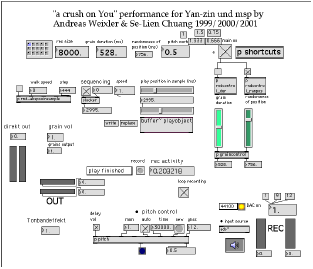
interactive audio visual
 The
Story
of H e i k e live in Nagoya, Japan
The
Story
of H e i k e live in Nagoya, Japan
The Story of H e i k e (Japanese traditional narrative
story)
interactive audiovisual performance
description:
the biwa player tells the traditional Japanese story of Heike.
The computer cotnrolled choice of picture interactively accompanies
the play of the biwa and the singing voice of the narrator.
Kagusho Kitagawa,
biwa
Mikako Mizuno, art concept
Se-Lien Chuang,
visuals
& realtime arrangement
Andreas Weixler, interactive
programming
Premiere: Nagoya City University - School Design and
Architecture,
Japan,
Friday 16th of February 2001, Sound Lab
technique: Max/msp (fiddle~ object for analysis of
pitch
and dynamic, generating algorithmic structures), and X-Pose visual
sampler.
 living
cave live in Laval, France
living
cave live in Laval, France
© Chuang Se-Lien
living cave
interactive audio-visual installation by Se-Lien Chuang, Max/msp
programming
by Andreas Weixler
description: The room reacts to the audience in algorithmic choice of pictures and their transformation and processes realtime audio within an electroacoustic composition.
Studio: Sound Design Lab/Nagoya City University, School of Design
and
Architecture, Japan
premiere: 19.01.2001 Nagoya, Sound Design Lab/Nagoya City University,
Japan
further premieres 16.-2o th of May 2001 at Laval Virtual and
VRIC (Virtual International International Conference), France.
technique: Max/msp (fiddle~ object for analysis of
pitch
and dynamic, generating algortihmic structures), and X-Pose visual
sampler.
mov
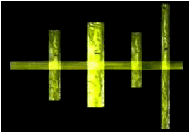
the movement and speed of a video by Se-Lien
Chuang
is controlled by pitches. Soundstudio of Nagoya City University, School
of Design and Architecture.
Two examples, one with the Nato object 242.pupille and one with the software BigEye by STEIM in Amsterdam.
 Ouroboros
at
Durham Art Gallery, Canada
Ouroboros
at
Durham Art Gallery, Canada
Ouroboros (2000)
Video on the Genom project by Gertrude Moser-Wagner, interactive sound
modulation by Andreas Weixler
For the realization in sound regarding the original concept of
Gertrude
Moser Wagner´s "Ouroboros" (www.art-metabolism.com)) I used
techniques
of computer music:
I first used granular synthesis of the spoken word "Ouroboros," and
then added the distorted resynthesis of a pitch tracking signal, which
I calculated corresponding to the two
channels of the stereo granular process - alltogether as a realtime
process. This meets the idea of the genome project to reorganize
original
(gen-, audio-) material.
In a version of audio visual interactivity the movment of the ROL6
worm
is followed by video object tracking of an radioactive marker. The
parameters
generated by this are used for controlling the sound process.
.
produced at Atelier Avant Aweixler
Hardware: PowerMacintosh 7200, Software: Max/msp 3.5.9,
Nato.
www.art-metabolism.com
premiere 08. 09 2000 Durham Art Gallery, Canada
other presentations: Kentler International Drawing Space, New York.
7.10. 2000
Origami
Japanese origami paper is controlling the sound.
Experiments
with Big Eye object tracking. The generated midi data will be processed
for sound and visuals.
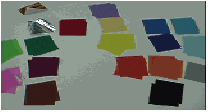
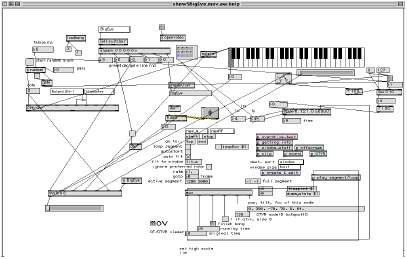
e.g. living cave (Chuang-Weixler 2001), uses audio input and generates an ambience of visuals and surrounding sound out of this.
Very often Max/msp is used in combination of other
software
and hardware.
e.g. X-pose visual sampler, or BigEye object tracking,
Hyperprism sound processing and others.
 living cave in Laval Virtual, Frankreich
living cave in Laval Virtual, Frankreich
training
1983 University of Music and Technical University
Graz: electrical engineering, sound engineering, from 1986 Graz
University
of Music and Dramatic Arts: composition (Andrzej Dobrowolski, Younghi
Pagh-
Paan, Beat Furrer), diploma 1995, Mag. art. (M.A. in arts) 1997;
2000-2001 special researcher in computer music
and audiovisual media arts at Nagoya City University, School of Design
and Architecture, Nagoya, Japan within the Japan Foundation Fellowship
Programm.
activities
performances in Europe, Asia, North and
South America. Numerous musical projects and groups in the field of
jazz
related music, music for contemporary theatre and dance,
contemporary
composition and computer music, video and interactive media arts.
recent performances: Laval Virtual 01 (France), Experimental Intermedia 00 (NYC, USA), Artport 01 (Nagoya, Japan), ISEA International Symposium on Electronic Art (Nagoya, Japan)
1992 - 1999 Graz University of Arts, Institute
for Electronic Music: teaching contract,
since 1997 at the
Bruckner-conservatory
Linz: teacher for music and media technology
1992 to 1999 editor of a cycle of publications
"Beiträge zur Elektronischen Musik" (contributions to
electronic
music),
1992-1996, member of the board of
the composers union "die andere saite", since 1996 member of the board
of the Austrian Society of Electroacoustic Music.
http://avant.mur.at/weixler
email: aweixler@sime.com
training
1990 Bachelor of Arts, Tamkang University/Taiwan:
German studies;
1996 diploma, University of Music and Dramatic
Arts Graz: piano education-teaching license (Walter Groppenberger);
since
1996 University of Music and Dramatic Arts Graz: composition (Beat
Furrer),
University of Music and Dramatic Arts Vienna: Electroacoustic Music
(Tamas
Ungvary, Wolfgang Musil); 1999 diploma with distinction,
Bruckner-Conservatory
Linz/Austria: Music and Media Technology (Adelhard
Roidinger,
Karlheinz Essl);
1999 scholarship of Werkstadt Graz for Silicon
Graphics studio training (computer animation), Austria
2000-01 special research in computer music &
audiovisual arts at Nagoya City University, Japan
activities
video and media artist, pianist for classical
and contemporay interactive music, composer for contemporary
instrumental
music, computer music;
composer in residence 1996: SAMT (Studio for
Advanced Music and Media Technology) Linz/A, UEA (University of
East
Anglia) and BEAST (Birmingham Electro Acoustic Sound
Theatre) England, 1999: SUSS (Sheffield
University Sound Studio) England;
concerts & presentations: d.a.s. (die andere saite) 1997-2000, 1997-2000 and numerous musical projects and groups 1996-2000 in Austria, Germany, Belgium, Netherland, England, France, Hungary,USA, Russia, Brazil, China and Japan;
recent performances: ISEA 02 (International Symposium on Electronic Art, Nagoya, Japan), SICMF 02 (Seoul International Computer Music Festival), Laval Virtual 01 (France), Experimental Intermedia 00 (NYC, USA), Artport 01 (Nagoya, Japan)
http://avant.mur.at/chuang
email: cse-lien@sime.com